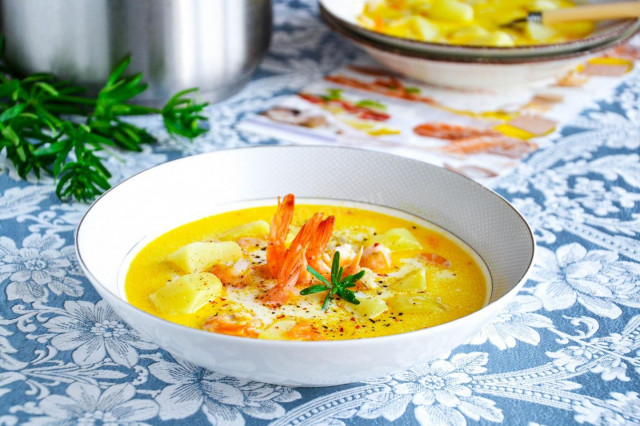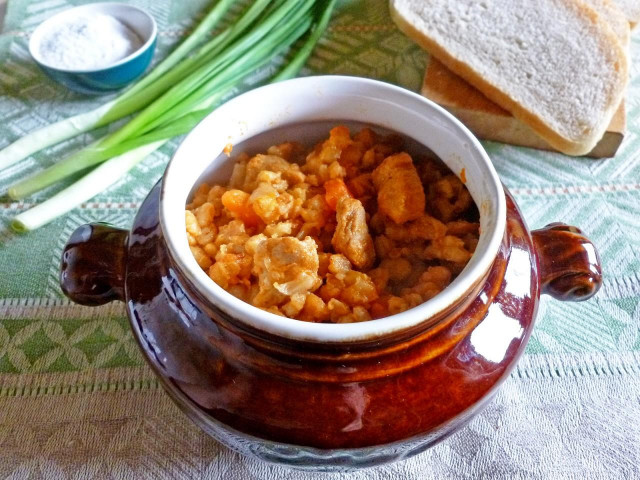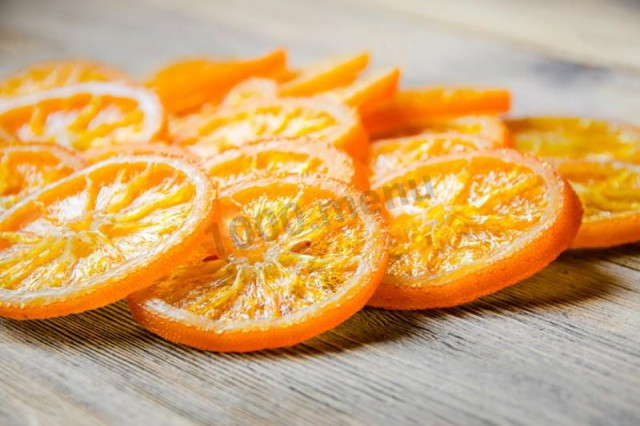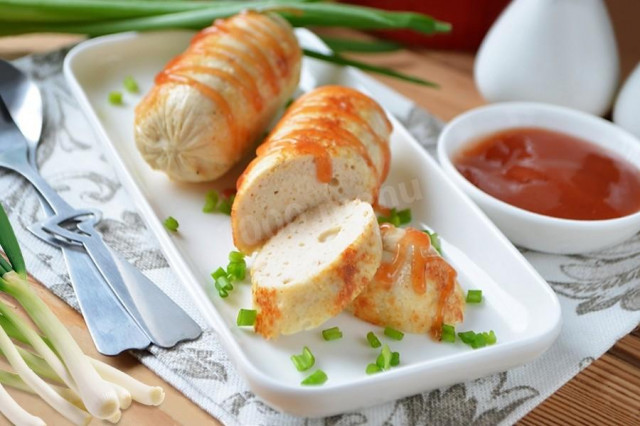Composition / ingredients
Step-by-step cooking
Step 1:
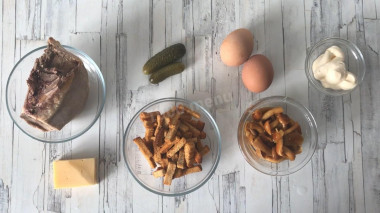
How to make a simple salad with tongue? Prepare the products. The tongue and eggs will need boiled. Mushrooms are preferable to honeydew, small in size, which can be put in a whole salad — they are brighter in taste and look beautiful in a salad. Put them in a colander and let the marinade drain.
Step 2:

Pre-boil and cool the tongue. Remove the skin. Cut the tongue into strips.
Step 3:

Cut the cheese into small cubes. Hard or semi-hard cheese is suitable, the main thing is that it is delicious and without milk fat substitutes.
Step 4:

Cut cucumbers into the same cubes. If you have gherkins, it is better to take more — 3-4 pieces.
Step 5:
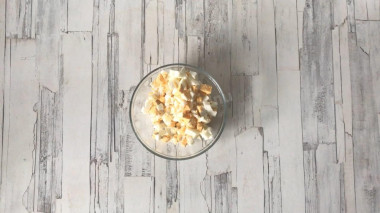
Hard-boiled eggs, cool, peel and cut into cubes.
Step 6:

In a salad bowl, combine the tongue, honeydew, cheese, cucumbers, eggs and crackers. Crackers are suitable for both purchased and self-made at home from rye bread.
Step 7:

Season the salad with mayonnaise. You can also make mayonnaise yourself.
Step 8:
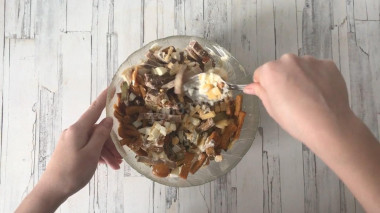
Mix everything well and serve immediately, otherwise the crackers may get wet and stop crunching. Enjoy your meal!
How to cook the tongue? Pre—soak it in cold water for 30 minutes - it will be softer and more tender. Then drain the water, put the tongue in a saucepan and fill with clean water. Put it to cook over medium heat. After boiling, remove the foam and boil the tongue for 15 minutes. After that, drain the water, pour in fresh and put it to boil again. This will get rid of the smell. The cooking time is from 2 to 4 hours, depending on the size of the tongue. When cooking, you can add salt, spices, vegetables to taste. To make the tongue easier to clean, immediately after cooking, fill it with cold water.
The salad will look nice and neat if you cut all the ingredients into pieces of the same size and shape (for example, cubes).
How to cook hard-boiled eggs? So that the eggs do not crack when cooking, put them in cold water and put them to cook on a small fire. Boil the eggs for 9 minutes after boiling, then pour cold water and cool. From a sharp temperature drop, the shell will be better cleaned.
Note that canned mushrooms are often stored in stores with a violation of the temperature regime (above 25 degrees, especially in summer). This can lead to the development of bacteria that cause severe poisoning and botulism.
Signs of improper storage are: a swollen jar, cloudy marinade, air bubbles rising from the bottom of the jar, the presence of mold and an unpleasant smell. If at least one of the listed signs is detected, it is better not to use such mushrooms at all. If you are sure that the canned mushrooms were stored correctly, then you can use them without frying. In the case when there seem to be no signs, but you doubt it, it is better to fry the mushrooms in vegetable oil until golden brown.
Caloric content of the products possible in the composition of the dish
- Chicken egg - 157 kcal/100g
- Egg white - 45 kcal/100g
- Egg powder - 542 kcal/100g
- Egg yolk - 352 kcal/100g
- Ostrich egg - 118 kcal/100g
- Dutch cheese - 352 kcal/100g
- Swiss cheese - 335 kcal/100g
- Russian cheese - 366 kcal/100g
- Kostroma cheese - 345 kcal/100g
- Yaroslavsky cheese - 361 kcal/100g
- Altai cheese 50% fat content - 356 kcal/100g
- Soviet cheese - 400 kcal/100g
- Cheese "steppe" - 362 kcal/100g
- Uglichsky cheese - 347 kcal/100g
- Poshekhonsky cheese - 350 kcal/100g
- Lambert cheese - 377 kcal/100g
- Appnzeller cheese with 50% fat content - 400 kcal/100g
- Chester cheese with 50% fat content - 363 kcal/100g
- Edamer cheese with 40% fat content - 340 kcal/100g
- Cheese with mushrooms of 50% fat content - 395 kcal/100g
- Emmental cheese with 45% fat content - 420 kcal/100g
- Gouda cheese with 45% fat content - 356 kcal/100g
- Aiadeus cheese - 364 kcal/100g
- Dom blanc cheese (semi-hard) - 360 kcal/100g
- Cheese "lo spalmino" - 61 kcal/100g
- Cheese "etorki" (sheep, hard) - 401 kcal/100g
- White cheese - 100 kcal/100g
- Fat yellow cheese - 260 kcal/100g
- Altai cheese - 355 kcal/100g
- Kaunas cheese - 355 kcal/100g
- Latvian cheese - 316 kcal/100g
- Limburger cheese - 327 kcal/100g
- Lithuanian cheese - 250 kcal/100g
- Lake cheese - 350 kcal/100g
- Gruyere cheese - 396 kcal/100g
- Cream crackers - 414 kcal/100g
- Wheat crackers - 331 kcal/100g
- Crackers - 331 kcal/100g
- Salad mayonnaise of 50 % fat content - 502 kcal/100g
- Light mayonnaise - 260 kcal/100g
- Provencal Mayonnaise - 624 kcal/100g
- Provencal mayonnaise - 627 kcal/100g
- Table mayonnaise - 627 kcal/100g
- Veal tongue - 160 kcal/100g
- Beef tongue - 146 kcal/100g
- Pig tongue - 300 kcal/100g
- Tongue sausage - 215 kcal/100g
- Pickled champignons - 12 kcal/100g
- Pickled cucumbers - 16 kcal/100g



